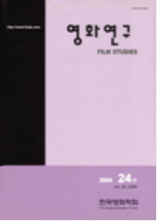- 영문명
- Types of Voice-over and the Korean Films around 1960: Focusing on the analysis of Gu Bong-Seo's Parvenu(1961)
- 발행기관
- 한국영화학회
- 저자명
- 장우진
- 간행물 정보
- 『영화연구』제24호, 421~461쪽, 전체 41쪽
- 주제분류
- 예술체육 > 예술일반
- 파일형태
- 발행일자
- 2004.12.31
7,720원
구매일시로부터 72시간 이내에 다운로드 가능합니다.
이 학술논문 정보는 (주)교보문고와 각 발행기관 사이에 저작물 이용 계약이 체결된 것으로, 교보문고를 통해 제공되고 있습니다.

국문 초록
영문 초록
Voice-over is a compound word. It consists of ‘voice’ and ‘over’. ‘Voice’ means the sound that we can hear when someone is speaking. ‘Over’ is related to the relationship between the sound and the images; when a voice doesn't come from the images but from another level of the discourse, we call it voice-over. There are two types of voice-over. One is voice-over heard by the subject. The other is voice-over telling. ‘Voice-over heard’ can be retrospective or hallucinatory. ‘Voice-over telling’ is divided into two categories: the voice-over that tells and controls the whole story and the voice-over that is contained in the story. Voice-over telling and controlling the whole story can come from either outside or inside of the diegesis. If it comes from outside of the diegesis, we call it extra-diegetic. The speaker of the extra-diegetic voice-over can be identified or remain anonymous. If the voice-over comes from inside of the diegesis, we call it intra-diegetic. The listener of the intra-diegetic voice-over can be another character or spectators. When a voice-over is contained in the story, it must be one of the next three: character voice-over contained, interior monologue, or substitution for written narration. Voice-over seems to begin being used around 1955 in Korean films. In 1950's, most of them were contained in the story. It seemed that voice-over began to tell and control the whole story by extra-diegetic narrator around 1960. For example, that kind of voice-over was used in Ah! White Tiger Kim Gu(1960), Concubine Chang(1961), Gu Bong-Seo's Parvenu(1961), etc. Among them, Gu Bong-Seo's Parvenu used diverse types of voice-over most variously. This essay analyses the use and effects of each type of voice-overs in Gu Bong-Seo's Parvenu. It might be helpful to find out how elaboratory each voice-over was used in Korean films around 1960.
목차
1. 들어가는 말
2. 보이스오버, 보이스오프, 보이스오버 내레이션
3. 보이스오버의 유형들
4. 보이스오버의 다양한 유형과〈구봉서의 벼락부자〉
5. 맺음말
키워드
해당간행물 수록 논문
- 멜로드라마에 나타난 남녀/관계 재현의 변화
- 우리 영화의 기원으로서 연쇄극에 관한 시론
- 영화교육 및 교직과정 연구
- 한국 영화에서 작가(주의) 담론의 역할에 대한 연구
- 디지털 영상제작 환경 분석을 통한 영화의질적 기여도에 대하여
- 정보의 바다에서사이버그는 무엇을 꿈꾸는가?
- 포스트 할리우드 시대의 미국 극장 산업의 변화
- 각본의 시각화에 대한 연구
- 촬영감독 콘래드 홀에 대한 연구
- 1920년대 초 조선총독부 활동사진반의 역할에 관한 연구
- 1990년대 한국 영화에 나타난 가족의미의 변화
- 사단법인 한국영화학회 정관 외
- <샤이닝>에 있어서 다양한 시점숏의 의미 분석
- 희생양그리고 민족적 알레고리로서 여성이미지 분석
- 한국영화의 생존력 제고를 위한 연구
- 국내 멀티플렉스의 현황과 시설변화 추이
- 현대 한국영화에서 프로듀서의 중요성과 역할 연구
- 필름과 비디오의 MTF 비교
- Buster Keaton 코미디 원형에 대한 연구
- 보이스오버의 유형과 1960년 전후의 한국영화
- 영화적 시각의 변형에 대한 연구
- 조선무성영화 변사의 기능적 고찰과 미학 연구
참고문헌
관련논문
예술체육 > 예술일반분야 BEST
- 생성형 AI 도구와 디자이너의 협업 프로세스 개발 - 이미지를 통한 아이디어 확산에서 고해상도 렌더링까지
- 영화 [올드보이]와 소포클레스 「오이디푸스 왕」의 상동성 연구
- ‘일과 삶의 균형(Work-Life Balance)’ 척도 개발을 위한 연구
최근 이용한 논문
교보eBook 첫 방문을 환영 합니다!

신규가입 혜택 지급이 완료 되었습니다.
바로 사용 가능한 교보e캐시 1,000원 (유효기간 7일)
지금 바로 교보eBook의 다양한 콘텐츠를 이용해 보세요!



